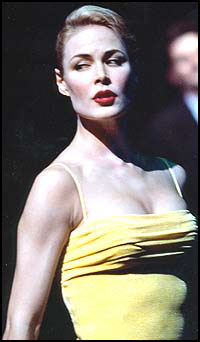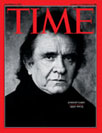Project for the
New Century
“A bully can be stopped, and so can a mob. It takes one person with the courage and a resolute voice.”
— Tim Robbins, speech to National Press Club, April 15, 2003
Resoluteness is a necessary, but not sufficient, condition for such a voice. Also needed is eloquence. Here is such a voice:
Postscript:
I wrote the above at 3:38 PM today, thinking I had finally found someone to admire whom my left-leaning friends might also admire.
Perhaps resoluteness and eloquence suffice to stop a mob; they are not, however, sufficient to impress professional journalists, who, to be much impressed, require a third quality– truthfulness.
Since today’s major Washington and New York papers indicate that a presidential scandal of Water- or Monica-gate proportions may be in the offing, some minimal fact-checking seems in order. Hence, at 3:40 PM today, I did a Google search on names Pitt discusses:
“karl rove”
“robert mosbacher”
novak.
That search indicates that unfortunately, mob-stopper Pitt seems, like many leftists, to be a liar.
Here is an excerpt from Pitt on Karl Rove dated Tuesday, Sept. 30, 2003:
The Most Insidious of Traitors
“Karl Rove, senior political advisor to George W. Bush, is a very powerful man. That is not to say he has never been in trouble. Rove was fired from the 1992 Bush Sr. campaign for trashing Robert Mosbacher, Jr., who was the chief fundraiser for the campaign and an avowed Bush loyalist. Rove accomplished this trashing of Mosbacher by planting a negative story with columnist Bob Novak. The campaign figured out that Karl had done the dirty deed, and he was given his walking papers.
Demonstrably, Rove is back in the saddle again. The January 2003 edition of Esquire magazine carried an article by Ron Suskind…. “
Here is an excerpt from columnist Robert Novak dated December 5, 2002:
“The article in Esquire’s January edition by Pulitzer Prize-winning journalist Ron Suskind is actually about Karl Rove, Bush’s powerful political adviser….
Unfortunately, I did not escape Suskind’s article, which includes these sentences: ‘Sources close to the former president say Rove was fired from the 1992 Bush presidential campaign after he planted a negative story with columnist Robert Novak about dissatisfaction with campaign fund-raising chief and Bush loyalist Robert Mosbacher Jr. It was smoked out, and he was summarily ousted.’ I was called by no fact-checker, who would have learned of multiple errors.
Suskind has confused former Secretary of Commerce Robert Mosbacher Sr., Bush’s 1992 chief fund-raiser, with his son Rob, who headed the Bush campaign in Texas (Victory ’92). Criticism of the younger Mosbacher, a frequent unsuccessful candidate in Texas, was not ‘planted’ with me by Rove but was passed to me by a Bush aide whom I interviewed. Rove was indeed fired by Mosbacher from Victory ’92 but continued as a national Bush-for-president operative.
Three mistakes in two sentences lend credence to claims by White House aides that they were misrepresented in Suskind’s July article…”
I say Pitt seems to be lying because in today’s editorial he never even mentions Novak’s column of December 5, 2002, which is, as noted above, readily available.
It is, of course, possible that Pitt and Suskind are right and Novak is wrong. It is also possible that Orwell was wrong, that Stalin was a great man, and that Communism is the wave of the future.






















































